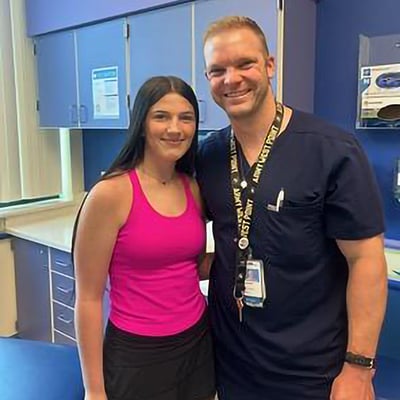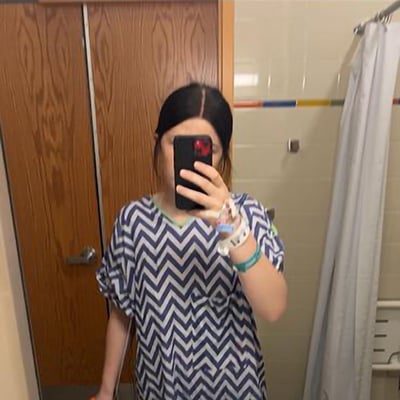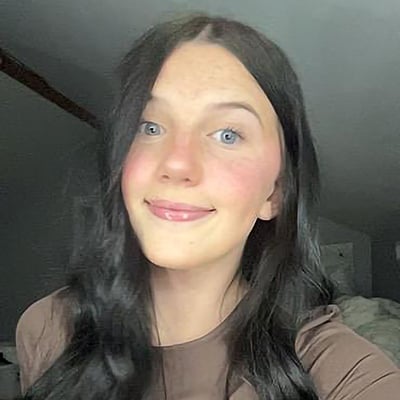Spinal Stress Fractures: Kyndall’s Story
14-year-old Kyndall is back on the volleyball court after more than 2 years of battling unrelenting back pain.
The eastern Missouri teen’s trouble started in March 2023. “My back was hurting any time I did anything,” said Kyndall. “I didn’t even know how to explain it; it just started hurting one day.”
Her local pediatrician ordered an X-ray and MRI, then referred her to an area orthopedic specialist who confirmed her spine was fractured. She wore a brace for 12 weeks and started physical therapy, but the pain continued. And continued. And continued.
“Her back hurt all the time,” Kyndall’s mom, Destayne, said. “She went to volleyball practice, but she came home crying. She couldn’t sit at a desk. Something was wrong.”
They kept pressing for answers but weren’t finding any solutions. By early 2025, Kyndall was beginning to experience numbness in her legs. They had more lab work and tests done — all negative, no cancer, no lupus — and were told to do more therapy and talk about pain management.
“I said, ‘Absolutely not,’” said Destayne. “That’s when I started Googling ‘top spine doctors in the U.S.’ I came across Dr. Shaw’s name.”
From a web search to spine surgery

Aaron Shaw, DO, FAAOS, is a physician on the Orthopedic Surgery and Spine Care teams at Children’s Mercy. Destayne called Children’s Mercy, had an in-depth conversation with the Spine Care team and scheduled an appointment for Kyndall with Dr. Shaw. They drove 4.5 hours to get to Kansas City in late April.
“She'd been through a lot: 2 years of chronic back pain and still trying to push through it to help her team,” said Dr. Shaw. “I think she's very selfless in that approach.” But no kid should have to suffer pain to play the sports they love. They started talking about Kyndall’s options.
“He was super nice and told me a lot about all the steps we could take to fix it,” said Kyndall.
“He sat with us and actually listened to us,” agreed Destayne. That same morning, the team was able to get Kyndall a CT scan, which showed what they had suspected.
"She had stress fractures on both sides of her spine, but they hadn’t healed — and didn’t really look like they were going to heal,” said Dr. Shaw.
Stress fractures can occur in young, active people, especially athletes who use repetitive hyperextension movements. “Certain athletes are more at risk: gymnasts, volleyball players and football players, especially the linemen,” explained Dr. Shaw. Most of these stress fractures will heal on their own with rest and therapy. But sometimes, like in Kyndall’s case, they just ... don’t.
“We talked about all the things you could do, which is what she had already been through,” said Dr. Shaw. “If we can avoid surgery, that's always the goal. But when we're getting to the point where they’re unable to do the things that they enjoy, and it's starting to affect quality of life and mental health, we have a good team that can help take care of those patients.”
Kyndall was a good candidate for a spine surgery technique developed by Children’s Mercy Section Chief John T. Anderson, MD, and Richard Schwend, MD, FAAP, FAOA, who recently retired from Children’s Mercy. Dr. Shaw and other spine surgeons here perform 10 to 15 of these procedures a year to help young athletes like Kyndall. They place a screw across the area to stabilize the fracture, clean out any scar tissue that has formed, then place a bone graft material to stimulate healing.
“We’ve had really good success with this particular technique,” said Dr. Shaw.
Pain-free for the first time in 2 years

Kyndall had the 3- to 4-hour surgery in mid-May. KC-area patients can have this surgery outpatient and go home the same night. But Kyndall stayed overnight to be better prepared for a long car ride home. She and her family raved about the inpatient care she received, including the team members who took the time to braid her hair.
“They were just there, and anything we needed or wanted, they got,” said Destayne. “It was truly an amazing experience.”
Dr. Shaw checked on her repeatedly until she was cleared to go home, in a pillow-filled car with detailed instructions for pain medicines, planned stops and making the drive as comfortable as possible.
Kyndall was blunt about her recovery: It was painful and hard for several weeks. “Then about 3 weeks after surgery, I stopped having pain,” said Kyndall. “I was confused because I've always had the pain there!”
“It was the first time she’d been pain-free for a day in over 2 years,” said Destayne.
It was a new experience for Kyndall, who was excited to get back to normal teen life. “I just wanted to go shopping every day,” laughed Kyndall, teasing her mom. “She wouldn’t take me.”
“Listen to your kids”
Technically, shopping isn’t prohibited post-surgery, but intense sports are.
“For the first 6 weeks after surgery, we don’t want patients to stress the area,” said Dr. Shaw. “We want the body to do its work, heal and grow that bone. No bending, lifting or twisting — just take it easy.”
After 6 weeks, patients can start increasing activity as they work on strengthening their core and lower back muscles and increasing their flexibility.
Slowly, Kyndall began to get back to the activities she loved this summer, including volleyball camp, even though she wasn’t able to participate fully. She has continued physical therapy with a local therapist and has follow-up visits with Dr. Shaw both in-person and virtually. She reports her back is feeling “amazing”!

Kyndall’s advice for other teenagers with chronic back pain? “Go see Dr. Shaw,” she laughed. “No, really, just find a good doctor and make sure you’re doing all your physical therapy. And don’t push yourself too hard!”
“Trust your kids and their bodies and what they’re saying,” added Destayne. “Listen to your kids. Get a second opinion if you need to. She would not be where she is today without that.”
Kyndall is playing for her 8th grade volleyball team now and hoping to play with the travel volleyball team that supported her through her spine surgery journey. She’s looking forward to a no-pain school year, including being able to do things with her friends, enjoy sporting events and maybe even run track in the spring.
“Kyndall is an amazingly resilient young lady,” said Dr. Shaw. “I'm very proud of the recovery that she's made so far and look forward to seeing what she's going to do in the future.”